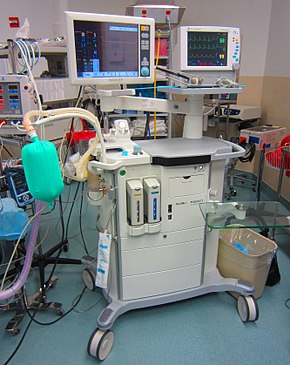Boyle's machine

An anaesthetic machine. This particular machine is a "Flow-I" model, manufactured by Maquet, a division of Getinge Group, Getinge, Sweden.
|
|
| Process type | physical change |
|---|---|
| Industrial sector(s) | anesthesia (medicine) |
| Main technologies or sub-processes | vaporization |
| Feedstock | inhalational anaesthetic agents, chiefly nitrous oxide and volatile anesthetics |
| Product(s) | phase transition of feedstock from the liquid phase to the gas phase |
| Leading companies | Leading companies using this industrial process |
| Main facilities | hospitals and outpatient surgery centers |
| Inventor | William T. G. Morton is widely credited for demonstrating the technique of vaporization of diethyl ether. However, many others were involved in its development. Please refer to History of general anesthesia article for more details. |
| Year of invention | 16 October 1846 |
The anaesthetic machine (UK English) or anesthesia machine (US English) or Boyle's machine is used independently by physician anaesthesiologists and nurse anaesthetists. Anaesthesiologist assistants also use anesthesia machines under the direct supervision of physician anesthesiologists. Anesthesia machines are used to support the administration of anaesthesia. The most common type of anaesthetic machine in use in the developed world is the continuous-flow anaesthetic machine, which is designed to provide an accurate and continuous supply of medical gases (such as oxygen and nitrous oxide), mixed with an accurate concentration of anaesthetic vapour (such as isoflurane), and deliver this to the patient at a safe pressure and flow. Modern machines incorporate a ventilator, suction unit, and patient monitoring devices.
The original concept of Boyle's machine was invented by the British anaesthetist Henry Boyle (1875–1941) in 1917. Prior to this time, anaesthetists often carried all their equipment with them, but the development of heavy, bulky cylinder storage and increasingly elaborate airway equipment meant that this was no longer practical for most circumstances. The anaesthetic machine is usually mounted on anti-static wheels for convenient transportation.
Simpler anaesthetic apparatus may be used in special circumstances, such as the TriService Apparatus, a simplified anaesthesia delivery system invented for the British armed forces, which is light and portable and may be used effectively even when no medical gases are available. This device has unidirectional valves which suck in ambient air which can be enriched with oxygen from a cylinder, with the help of a set of bellows. A large number of draw-over type of anaesthesia devices are still in use in India for administering an air-ether mixture to the patient, which can be enriched with oxygen.
Many of the early innovations in U.S. anaesthetic equipment, including the closed circuit carbon-dioxide absorber (a.k.a. the Guedel-Foregger Midget) and diffusion of such equipment to anaesthetists within the United States can be attributed to Richard von Foregger and The Foregger Company.
...
Wikipedia
